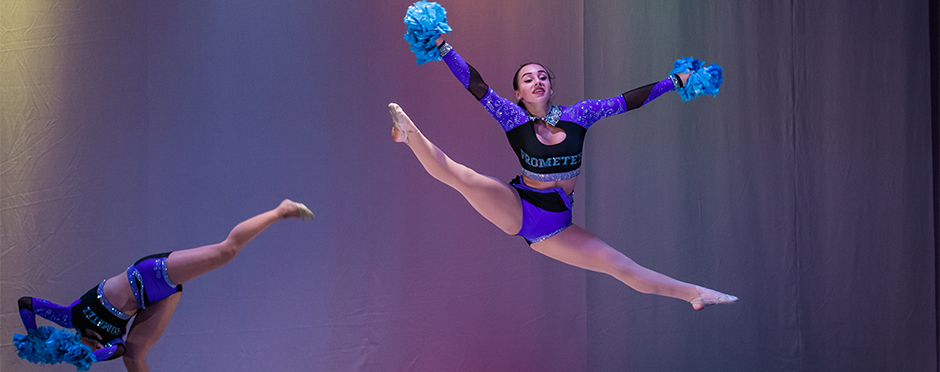
Stretch Rx for Achieving the Splits
Leave a CommentIs your goal to learn the splits?
Beyond just improving flexibility, this skill can be useful for athletes in a variety of sports – from gymnasts and cheerleaders to hockey goalies. However, learning to safely perform this movement takes a lot of practice and consistency. See below for recommended stretches and some evidence-based tips for improving your flexibility and achieving this goal.
Know your target muscles: You need adequate flexibility of your glutes and hamstrings in order for your front leg to be able to extend forward. Your hip flexors, adductors and quadriceps need to lengthen in order to achieve the position of your back limb extending away.
Consider the timing of your stretching:
- Stretch after activity – The key stretches listed below and the splits stretch itself are considered static stretches. A static stretch is a stretch that is held for a prolonged duration (typically > 30 seconds). It is not advisable to perform static stretches if your muscles are “cold.” It is recommended that prior to stretching you perform a warm-up of dynamic movements for at least five minutes. Dynamic body movement will increase blood flow and tissue temperature in the muscles, tendons, and ligaments that you intend to stretch, which makes the tissue more easily extensible, and less likely to become injured while stretching. A few examples of dynamic stretches include walking lunges, arm swings and tuck jumps.
- Stretching immediately prior to activity may impair performance – A study of rhythmic gymnasts found a significant decrease in “flight time” of the gymnast’s leaps when splits stretching was performed immediately prior to athletic performance.1 The authors of the study discussed how the muscles’ ability to activate in a powerful way is temporarily adversely affected by stretching. So if you are a dancer, gymnast or cheerleader, it is recommended that you either stretch toward the beginning or the very end of your rehearsal or practice for peak jump performance.
Hold stretches for proper duration: There is no one direct answer to the question of how long to hold a stretch. The American College of Sports Medicine’s recommendation is a stretch duration of 15-30 seconds, repeating the stretch 2-4 times.2
Commit to your flexibility program: Again, there is not a frequency of stretching that appears to provide the greatest benefit. For example, when it comes to stretching your hamstrings one study reported flexibility improves when you stretch 3-5 days per week. You can expect it to take anywhere from 3-6 weeks before you notice significant improvements.3 Interestingly, the study found that both a supine (lying down) and standing hamstrings stretch were equally effective. So choose your stretches based on what is the most comfortable for you.
- Foam roll: There is research that suggests that foam rolling your quadriceps and hamstrings results in short-term improvement in hip extension and hip flexion range of motion.4 Therefore, consider foam rolling these target muscles prior to stretching for increased effectiveness.
Key Stretches for Hamstrings:
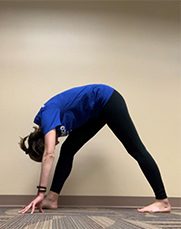
Figure 1: Forward Triangle Stretch
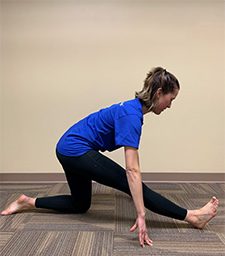
Figure 2: Half Split Stretch
For the forward triangle stretch and half splits stretch (featured above) focus on keeping your spine as straight as possible. You can place yoga blocks under your hands if you are having difficulty reaching the floor. To progress the half splits stretch, try straightening your back leg. When you work on straightening your back leg you can use a yoga block or strap propped under the thigh of your front leg for more support if the stretch is too intense.
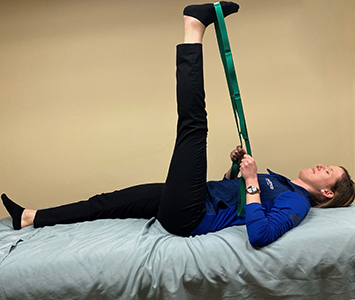
Figure 3: Supine Hamstrings Stretch
Performing hamstrings stretches in a supine position (pictured above) allows you to use the strap to help pull your leg toward you. Working toward a split in this position may be more tolerable than trying to sit in a splits on the floor.
Key Stretches for Hip Flexors and Quadriceps:
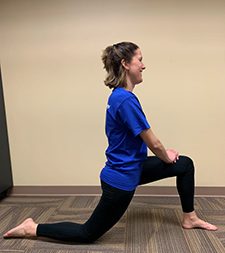
Figure 4: Runner’s Lunge
For this kneeling stretch try tucking your pelvis under you by flattening your lower back and tightening your abdominals before you lunge forwards to increase the stretch of your hip flexors (front pocket area).
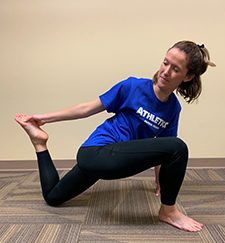
Figure 5: Revolved Lunge with Quadriceps Stretch
You can progress the stretch by twisting through your spine and bending your back knee. This will overall increase the intensity of the stretch by adding in the quadriceps of your back leg. Bend your knee carefully with a flexed foot to avoid experiencing a hamstrings cramp.
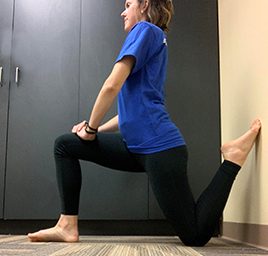
Figure 6: Knee Up Wall Lunge
You can further progress this stretch in front of a wall, working towards progressively bending your knee more until your heel is near your glute. Focus on keeping your hips upright.
Glutes, Hamstrings, Hip Flexors:
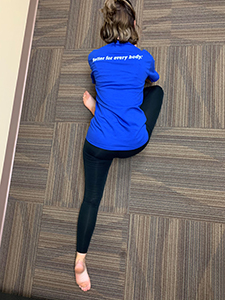
Figure 7: Pigeon Pose
The pigeon pose stretch works on getting your back leg into the extended position. Since your front knee is bent it decreases the load on the hamstrings compared to a full splits.
Improving Flexibility
Flexibility is a key component of several activities. When beginning a stretching program it is important to be attentive to what you are feeling in your muscles. You should expect a feeling of gentle pulling, tugging, or just general sensation during the stretch. You should not push yourself to an intensity or duration of stretch that is painful.
Some delayed onset muscle soreness would not be unusual after a stretching session. However discomfort should not persist for more than three days if you are stretching appropriately. If you have a history of injury or are recovering from an injury, consider seeing a physical therapist to safely prescribe and progress a flexibility program tailored to your individual needs.
The Athletico blog is an educational resource written by Athletico employees. Athletico bloggers are licensed professionals who abide by the code of ethics outlined by their respective professional associations. The content published in blog posts represents the opinion of the individual author based on their expertise and experience. The content provided in this blog is for informational purposes only, does not constitute medical advice and should not be relied on for making personal health decisions.
References:
1. Cagno, Alessandra Di, et al. “Preexercise Static Stretching Effect on Leaping Performance in Elite Rhythmic Gymnasts.” Journal of Strength and Conditioning Research, vol. 24, no. 8, Aug. 2010, pp. 1995–2000., doi:10.1519/jsc.0b013e3181e34811.
2. Page, Phil. “Current Concepts in Muscle Stretching for Exercise and Rehabilitation.” The International Journal of Sports Physical Therapy, vol. 7, no. 1, Feb. 2012, pp. 109–119.
3. Decoster, Laura C et al. “Standing and Supine Hamstring Stretching Are Equally Effective.” Journal of athletic training vol. 39,4 (2004): 330-334.
4. Cheatham, Scott W et al. “The effects of self-myofascial release using a foam roll or roller massager on joint range of motion, muscle recovery, and performance: A systematic review.” International journal of sports physical therapy vol. 10,6 (2015): 827-38.
